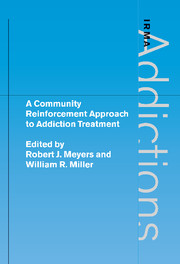Book contents
- Frontmatter
- Contents
- List of contributors
- Preface
- Acknowledgments
- 1 Developing the Community Reinforcement Approach
- 2 Practice and Promise: The Azrin Studies
- 3 The Treatment
- 4 A Comparison of CRA and Traditional Approaches
- 5 Community Reinforcement and Traditional Approaches: Findings of a Controlled Trial
- 6 CRA with the Homeless
- 7 CRA and Treatment of Cocaine and Opioid Dependence
- 8 Community Reinforcement and Family Training (CRAFT)
- 9 Summary and Reflections
- References
- Index
7 - CRA and Treatment of Cocaine and Opioid Dependence
Published online by Cambridge University Press: 05 August 2012
- Frontmatter
- Contents
- List of contributors
- Preface
- Acknowledgments
- 1 Developing the Community Reinforcement Approach
- 2 Practice and Promise: The Azrin Studies
- 3 The Treatment
- 4 A Comparison of CRA and Traditional Approaches
- 5 Community Reinforcement and Traditional Approaches: Findings of a Controlled Trial
- 6 CRA with the Homeless
- 7 CRA and Treatment of Cocaine and Opioid Dependence
- 8 Community Reinforcement and Family Training (CRAFT)
- 9 Summary and Reflections
- References
- Index
Summary
In this chapter we review research on use of the Community Reinforcement Approach (CRA) in outpatient treatment for cocaine and opioid dependence. Briefly, CRA is a multicomponent behavioral treatment that was originally developed for the treatment of alcoholism (Hunt & Azrin, 1973). CRA is designed to systematically facilitate changes in the client's daily environment to reduce substance abuse and promote a healthier lifestyle. Systematic efforts are made to increase the frequency and amount of reinforcement clients derive from their vocation, family relations, and social and recreational activities so that those areas might compete more successfully with the allure of the pharmacological and social reinforcement obtained through substance abuse. The treatment also involves skills training tailored to meet individual needs, including skills directly related to decreasing substance use (e.g., functional analysis of drug use, drug refusal training) and others important to increasing reinforcement derived from a healthier lifestyle (e.g., problem solving, social skills training, sleep-hygiene training). Treatment duration can vary from 2 to 6 months, and usually involves up to several individual therapy sessions weekly delivered by professional therapists trained in this treatment approach. CRA can also be delivered in group sessions (Azrin, 1976). Those interested in a more detailed description of CRA or information on clinical implementation should consult Chapters 1 and 3 of this volume and the published therapy manuals (Budney & Higgins, 1998; Meyers & Smith, 1995).
Effective psychosocial interventions like CRA are fundamentally important to the treatment of cocaine and opioid dependence. Psychosocial interventions are the only treatments demonstrated to be reliably efficacious with cocaine-dependent individuals (Higgins & Wong, 1998).
Keywords
- Type
- Chapter
- Information
- A Community Reinforcement Approach to Addiction Treatment , pp. 123 - 146Publisher: Cambridge University PressPrint publication year: 2001
- 6
- Cited by

